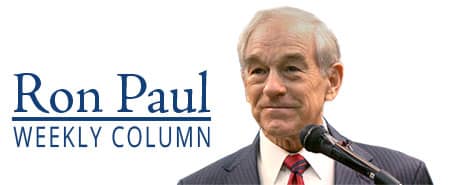
April’s 4.2 percent past year increase in the Consumer Price Index is not likely to dissuade the Federal Reserve from continuing its policy of near-zero interest rates. Fed Chairman Jerome Powell believes the rising prices are just a temporary phenomenon caused by the ending of lockdowns releasing pent-up consumer demand.
Powell may be right that the ending of lockdowns would inevitably be accompanied by a rise in prices. However, this is just the latest reason the Fed has given for putting off increasing interest rates. Powell does not want to admit that the real reason the Fed will continue to keep rates low is that increasing rates will cause the federal government’s interest payments to rise to unsustainable levels.
One way the Fed increases the money supply — and thus lowers interest rates — is by purchasing US Treasury securities. These purchases increase demand for US government debt, keeping government’s borrowing costs low. An expansionary monetary policy thus enables increased federal spending and deficits. Since the lockdowns, the Fed has worked overtime to monetize federal debt, doubling its holdings of Treasury securities.
A Truth in Accounting report from April concluded the real federal debt is 123 trillion dollars — over four times larger than the 28 trillion dollars “official” debt. The higher debt calculation includes the federal government’s unfunded liabilities. The biggest unfunded liabilities are the 55 trillion dollars in promised but unfunded Medicare benefits and the 41 trillion dollars in promised but unfunded Social Security benefits.
Congress could transition away from entitlement and welfare programs without harming current or soon-to-be beneficiaries by cutting spending on militarism and corporate welfare. Part of the savings from these cuts could be used to pay down the debt, and part could be used to provide payments for current and soon-to-be beneficiaries of government programs while we transition to a free market.
Unfortunately, there is not much appetite in Congress for spending cuts. The main Democratic criticisms of President Biden’s 1.52 trillion dollars budget, which increases spending by 8.4 percent, are that Biden is not proposing bigger increases in spending and debt, or in taxes on “the rich.” Biden’s budget increases are in addition to the trillions in other spending Biden is pursuing, including related to Covid, infrastructure, and his “American Families Plan.”
Republicans are making obligatory attacks on Biden’s spending, while also attacking Biden for increasing military spending to “only” 753 billion dollars. Republican complaints about Biden’s big spending ring hollow given their support for Presidents Donald Trump and George W. Bush’s spending increases and Republicans’ proposals to spend billions on infrastructure.
Some conservatives have even embraced the madness of Modern Monetary Theory. These conservatives are urging people to stop worrying about spending and debt and instead figure out how to use Fed-financed government spending to advance conservative ends.
The refusal of Congress to cut spending means the Fed will keep increasing its balance sheet in an effort to monetize skyrocketing debt. Eventually, the increasing debt and inflation will lead to a major economic meltdown. The meltdown will likely include a rejection of the dollar’s world reserve currency status.
The only way to avoid the crash is to spread the truth among enough people to force Congress to reverse course. Early steps in reversing course are blocking Biden’s big spending plans and passing Audit the Fed so the American people can finally know the truth about the Federal Reserve’s actions.

